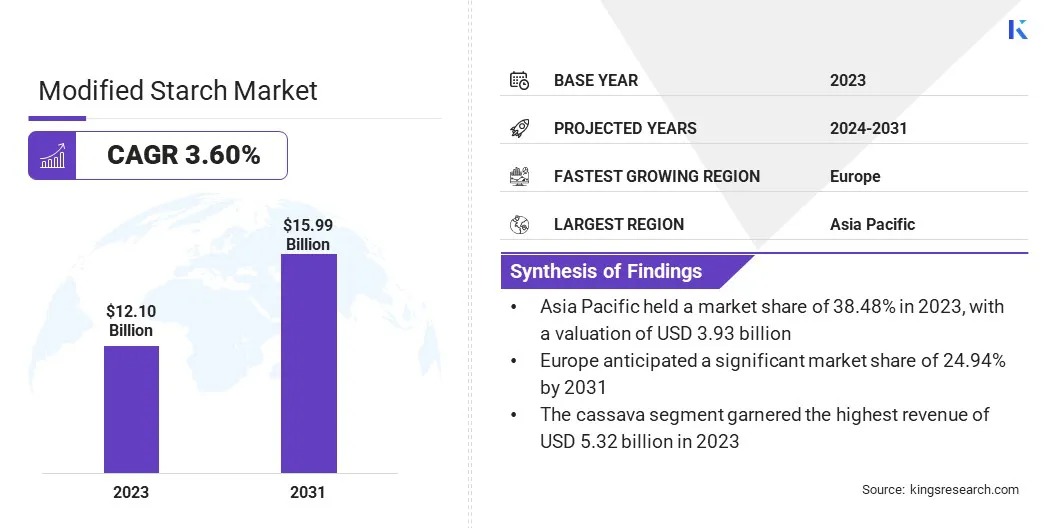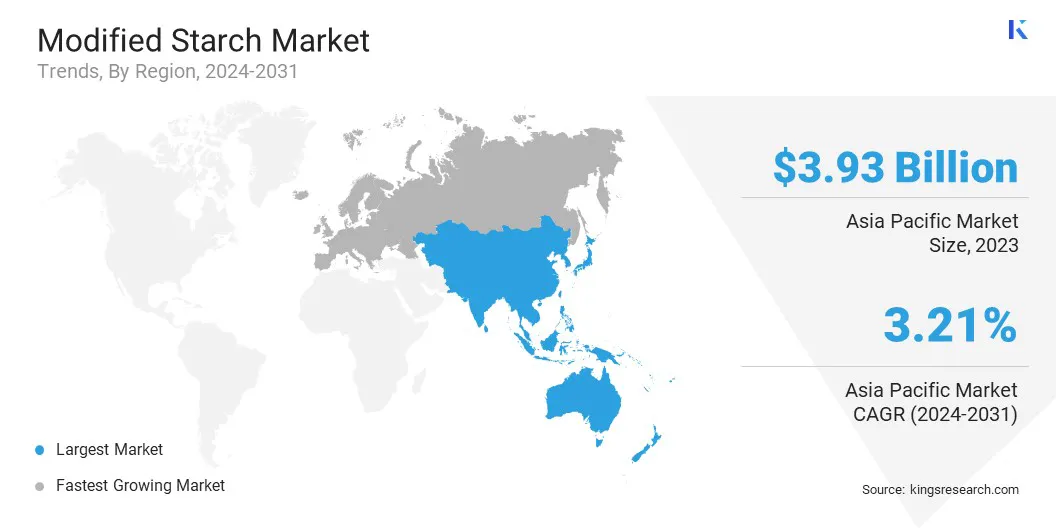Modified Starch Market Size
Global Modified Starch Market size was recorded at USD 12.10 billion in 2023, which is estimated to be at USD 12.48 billion in 2024 and projected to reach USD 15.99 billion by 2031, growing at a CAGR of 3.60% from 2024 to 2031. In the scope of work, the report includes products offered by companies such as ADM, AGRANA Beteiligungs-AG, Cargill, Incorporated., Grain Processing Corporation, Ingredion, Roquette Frères, Royal Ingredients Group, SMS Group, Tate & Lyle, AVEBE, and others.
The growth of the modified starch market is positively influenced by the increasing demand from diverse industries including food and beverage, pharmaceuticals, and paper production. This demand is further increased by factors such as the growing population, changing consumer preferences toward convenience foods, and the pressing need for sustainable packaging solutions.
Additionally, technological advancements in starch modification processes have led to improved functionality and versatility, thereby driving market growth. Moreover, the increasing awareness regarding the benefits of modified starches, such as enhanced texture, stability, and shelf-life extension, is contributing significantly to market expansion.
The modified starch market is a dynamic and rapidly evolving sector characterized by a wide range of applications across various industries. It encompasses starch derivatives that undergo modifications through physical, enzymatic, or chemical processes to enhance their properties.
Geographically, Asia-Pacific is dominating the market due to its large food processing industry and increasing industrialization. However, North America and Europe hold significant shares of the market owing to the increasing demand for modified starches in processed foods, pharmaceuticals, and other sectors. Modified starches include starches obtained from processes, including physical processes such as heat treatment, enzymatic treatments, or chemical alterations.
The market refers to the global trade and consumption of starch derivatives that undergo modifications to improve their functionality and performance in various applications. Modified starches find extensive use in diverse industries such as food and beverages, pharmaceuticals, paper manufacturing, and textiles, among others.
They offer characteristics such as thickening, stabilizing, binding, and gelling properties, making them versatile ingredients in numerous products. The market encompasses a diverse range of starch sources, including corn, wheat, potato, and tapioca, which are tailored to meet diverse customer needs and preferences.

Analyst’s Review
Manufacturers are making efforts to promote sustainability by leveraging renewable sources for modified starch production. Furthermore, they are engaging in innovation by developing new product formulations to meet evolving consumer preferences, with a focus on clean label, gluten-free, and plant-based options.
The market is witnessing a rise in novel applications, particularly in the pharmaceutical and cosmetic sectors. These strategic initiatives and steps depict the industry's adaptability to market trends, thus ensuring sustained growth and competitiveness.
Modified Starch Market Growth Factors
The ongoing shift toward clean label and natural ingredients in the food and beverage industry is a significant factor propelling the growth of the modified starch market. Consumers are increasingly preferring products with fewer artificial additives and chemicals, leading manufacturers to opt for modified starches as natural alternatives.
This demand is particularly pronounced in developed regions such as North America and Europe, where health-conscious consumers prioritize clean label products. Due to this, the demand for modified starches derived from natural sources such as tapioca, potato, and rice is witnessing a steady rise, thereby driving market growth.
The fluctuating prices of raw materials, particularly those pertaining to agricultural commodities such as corn and wheat, present a key challenge to industry growth. These price fluctuations impact production costs and profit margins for manufacturers.
To overcome this challenge, companies are increasingly adopting strategies such as diversifying their raw material sourcing, engaging in long-term contracts with suppliers, and investing in research and development to explore alternative starch sources. Additionally, implementing efficient inventory management practices and leveraging technology for forecasting and supply chain optimization helps mitigate the impact of raw material price volatility in the market.
Modified Starch Market Trends
The rising demand for plant-based and vegan-friendly products across various industries is a key trend shaping the market landscape. This is driven by increasing awareness regarding both health considerations and environmental sustainability.
As consumers prioritize healthier and eco-friendly options, manufacturers are incorporating modified starches derived from plant sources such as tapioca, rice, and corn to develop plant-based alternatives in food, beverages, and personal care products. This is further influencing product innovation, with companies focusing on creating clean label formulations to meet the growing demand for natural and sustainable ingredients.
The rising emphasis on functional properties and customization to meet diverse industry requirements is a significant trend in the modified starch market. Manufacturers are leveraging advanced processing techniques to modify starches with specific functionalities such as improved texture, stability, and shelf-life extension.
This is particularly evident in the food industry, where modified starches are used in gluten-free products, low-fat formulations, and texture enhancement in processed foods. Additionally, the pharmaceutical and cosmetic sectors are increasingly adopting modified starches due to their advantageous functional properties, thereby fostering a shift toward customization to cater to specific product needs and consumer preferences.
Segmentation Analysis
The global modified starch market is segmented based on source, application, and geography.
By Source
Based on source, the market is segmented into cassava, maize, potato, wheat, and rice. The cassava segment dominated the modified starch market, accounting for a valuation of USD 5.32 billion in 2023. This segmental growth is attributed to the unique advantages offered by cassava, such as high starch content, drought tolerance, and suitability for tropical climates, making it a preferred source for modified starch production.
Additionally, the growing demand for gluten-free and natural ingredient alternatives in the food industry has contributed to the increased popularity of cassava-based modified starches. Moreover, technological advancements in cassava processing and increased cultivation in key regions such as Asia-Pacific and Africa have supported segment expansion.
By Application
Based on application, the market is classified into food and beverage industry, pharmaceutical industry, paper & textile industry, animal feed industry, and others. The animal feed industry segment's significant growth, projected at a CAGR of 4.80% through the forecast period, is propelled by the increasing focus on animal nutrition and welfare, resulting in a rising demand for high-quality feed ingredients that offer nutritional benefits and improve feed efficiency.
Modified starches, with their functionalities such as binding, thickening, and energy supplementation, are increasingly being incorporated into animal feed formulations. Furthermore, the trend toward specialty and customized feed solutions to meet specific animal dietary requirements is fueling the adoption of modified starches in the animal feed industry, resulting in segmental expansion.
Modified Starch Market Regional Analysis
Based on region, the global modified starch market is classified into North America, Europe, Asia Pacific, MEA, and Latin America.

The Asia-Pacific Modified Starch Market share stood around 38.48% in 2023 in the global market, with a valuation of USD 3.93 billion, is fostered by its robust food processing industry, leading to increased demand for modified starches in various applications such as food, beverages, and pharmaceuticals.
Additionally, the substantial presence of major starch-producing countries such as China, Thailand, and India are contributing significantly to the region's dominance. Furthermore, favorable government policies, technological advancements in starch modification processes, and increasing investments in research and development are bolstering Asia-Pacifc modified starch market growth.
Europe's significant growth potential in the modified starch market, with an anticipated market share of 24.94% by 2031, attributable to the region's stringent regulations that promote clean label and natural ingredient formulations. This is boosting the demand for modified starches as healthier alternatives in the food and beverage industry.
Moreover, increasing consumer awareness regarding sustainability and environmental concerns is fueling the adoption of plant-based and eco-friendly ingredients, thereby supporting regional market growth. Additionally, Europe's strong presence in industries such as pharmaceuticals, paper & textiles, and cosmetics is solidifying the region's status as the fastest-growing market for modified starches.
Competitive Landscape
The global modified starch market study will provide valuable insight with an emphasis on the fragmented nature of the industry. Prominent players are focusing on several key business strategies such as partnerships, mergers and acquisitions, product innovations, and joint ventures to expand their product portfolio and increase their market shares across different regions.
Manufacturers are adopting a range of strategic initiatives, including investments in R&D activities, the establishment of new manufacturing facilities, and supply chain optimization, to strengthen their market standing.
List of Key Companies in Modified Starch Market
- ADM
- AGRANA Beteiligungs-AG
- Cargill, Incorporated.
- Grain Processing Corporation
- Ingredion
- Roquette Frères
- Royal Ingredients Group
- SMS Group
- Tate & Lyle
- AVEBE
Key Industry Developments
- February 2024 (Launch): Ingredion Incorporated unveiled NOVATION Indulge 2940 starch, a non-GMO functional native corn starch designed for dairy and alternative dairy products. This launch marks a significant expansion in their clean label texturizers line. The starch offers unique gelling and co-texturizing properties, enhancing both texture and mouthfeel. Its natural claim enablement and consumer-friendly "corn starch" label are in line with market preferences, showcasing Ingredion's commitment to innovation and meeting consumer demands.
- February 2024 (Launch): Royal Avebe introduced Etenia ES, a novel potato-based texturizing solution ideal for creamy dairy products. It addresses the challenge faced by dairy manufacturers in replacing milk protein, fat, and label-unfriendly hydrocolloids while preserving taste and texture. Etenia ES offers high process tolerance, easy integration into existing dairy processes, and benefits such as improved stability, clean label, allergen-free labeling, and versatile texture options from spoonable to spreadable, catering to evolving consumer demands for plant-based dairy products.
The Global Modified Starch Market is Segmented as:
By Source
- Cassava
- Maize
- Potato
- Wheat
- Rice
By Application
- Food and Beverage Industry
- Pharmaceutical Industry
- Paper & Textile Industry
- Animal Feed Industry
- Others
By Region
- North America
- Europe
- France
- U.K.
- Spain
- Germany
- Italy
- Russia
- Rest of Europe
- Asia-Pacific
- China
- Japan
- India
- South Korea
- Rest of Asia-Pacific
- Middle East & Africa
- GCC
- North Africa
- South Africa
- Rest of Middle East & Africa
- Latin America
- Brazil
- Argentina
- Rest of Latin America


